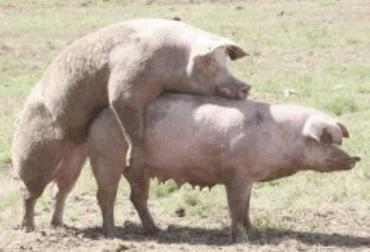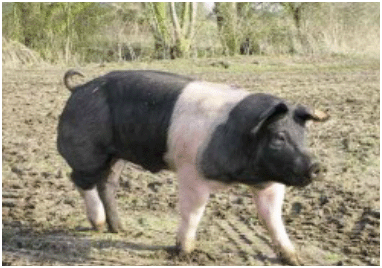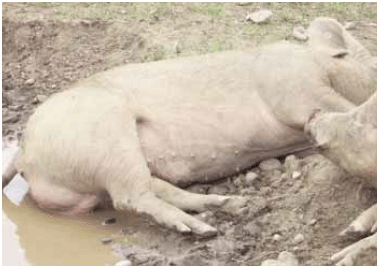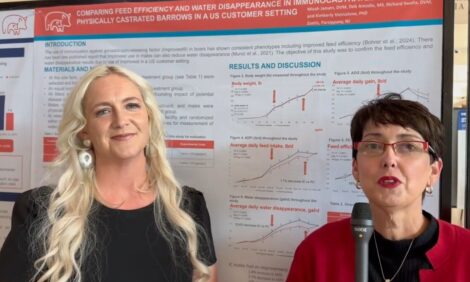



Heat Stress in Boars
No. 39 in the 'Action for Productivity' series from BPEX explains the impact high summer temperatures can have on fertility and offers advice on keeping boars cool.The boar’s fertility accounts for 50 per cent of his progeny’s genetics but potentially 100 per cent of output as poor quality semen affects both conception and litter size. This is of particular significance to units using DIY AI or natural service as their main service method.
Targets
- Maintain first service conception rate of 85 per cent plus throughout summer and up to eight weeks following hot temperatures
- Take appropriate measures to minimise heat stress
- Keep on top of boar replacement programme
Sperm Production
Sperm production occurs at 2 to 4ºC below body temperature (38.5 to 39.5ºC), however, as one-third of a boar’s testicles are inside the body, they are less effective at temperature regulation than other mammals with fully suspended scrotum.
Heat stress related boar infertility can last up to eight weeks following a period of hot weather. The testes operate as a production line with sperm at all stages of development being present at all times. If anything happens to the boar to damage this system, it can take up to eight weeks for new normal mature sperm to be produced.
Management Guidelines
- The same measures must be taken for the boars as for sows during periods of high temperatures, i.e. provision of wallows and shades (see Action for Productivity 4)
- Space is a critical factor and there must be ample space for lying, especially in groups of boars where territory is an extra factor to consider
- Reduce the amount of bedding used as this will insulate the boars from the cooling effect of lying directly on the ground
- Record periods of hot weather on a calendar and remember to check semen quality for up to eight weeks after the last period of heat stress
- If high temperatures are expected for long periods of time think about using AI for returns and for natural service units use AI six to eight weeks after extreme heat.
Libido
- Boar libido (interest in activity associated with mating) can be greatly reduced during hot weather
- Reduced libido will affect the natural mating process for weaned sows on natural service units, the stimulation of sows from weaning and when using boars for heat detection and stimulation during AI
- Young boars are less susceptible to heat stress and will be more active during hot periods; manage your system so that you have young boars ready for summer
- Boars will not work in hot conditions and encouraging them to do so is likely to increase heat stress
- Chaser boars will also be affected by high temperatures and become less effective at seeking out and mating return sows, resulting in missed sows, failed matings, poor reproductive performance and increased empty days.
Feed and Water
- During periods of hot weather appetite can be reduced
- Monitor body condition; if the boars start to utilise their own body reserves this will reduce the quality and number of sperm produced
- Ensure boars have access to a supply of clean water at all times
- The minimum requirement of water for boars is five to eight litres per day with a minimum flow rate of 2.0 litres per minute through nipple drinkers.

Chaser Boars
- Chaser boars can influence 15 to 20 per cent of serves so do not neglect them when making preparations for heat stress in summer
- The chaser boar must be fit and active as he must actively seek out the return sows and stimulate the weaned sows
- Monitor activity and change the boar if his activity levels fall
- Change chaser boars more regularly during the period after hot weather when more returns would be expected, in addition to the increased risk of the boars’ fertility being compromised
- The above point also applies to young boar groups used for serving gilts.

Indoors
- Use a max/min thermometer to monitor daily temperature in the boar house and record on collection sheet; highlight periods when boars were too hot
- Temperatures above 23°C can result in heat stress, be extra vigilant in assessing semen quality, especially three to five weeks after the heat challenge
- Carry out DIY AI at either end of the day when it will be cooler
- Use sprinklers or foggers if necessary and create an area of wet concrete for boars to lie on to keep cool
- Additional air movement, provided by a supplementary fan, can also assist with cooling the boar, provided he has the opportunity to wet his skin.

Summary
- Boars should be provided with the best environment possible to enhance their breeding performance:
- Create wallows and put shades in place
- Ensure there is a good water supply
- Feed during the coolest parts of the day
- Cull out boars which are lame and/or have low libidos
- Plan boar intake to ensure young, more active boars are available at the start of summer
- Plot and monitor performance and record periods of hot weather on a calendar
- Infections that raise a boar’s body temperature, or localised infections that raise the temperature of the scrotum and testes, will also result in changes in semen quality for up to eight weeks, similar to those that occur after boars are exposed to environmental heat stress

July 2013






